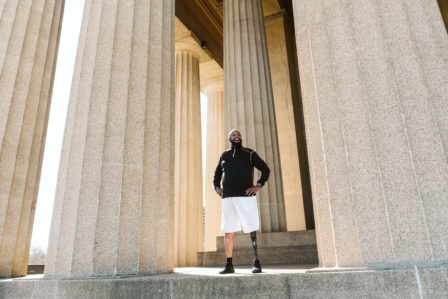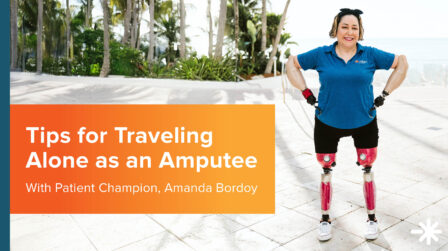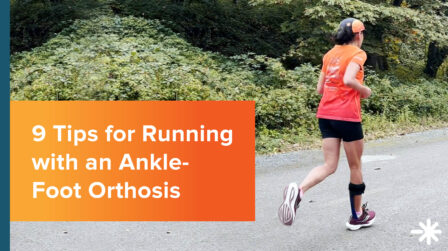Limb Loss and Limb Difference: Facts, Statistics, & Resources

With more than 2 million Americans living with limb loss and another 28 million at risk of amputation surgery, chances are you will encounter someone who has faced or is facing this difficult journey.1 In honor of Limb Limb Loss and Limb Difference Awareness month, get to know the facts, so you can be better equipped to provide support, compassion, and hope to those who need it most.
About Limb Loss and Limb Difference Awareness Month
The Amputee Coalition created Limb Loss and Limb Difference Awareness Month to honor the community and educate others about what it’s like to live with limb loss and limb difference. Learn why raising awareness is so important.

Three Common Causes of Limb Loss
Limb loss is more common than you might think. According to the Amputee Coalition, approximately 185,000 amputations occur in the United States each year and a staggering 3.6 million people will be living with limb loss—the surgical removal (amputation) of an arm or leg—by 2050.2
Limb loss has three main causes, the most common of which is vascular disease, affecting 54% of this population.2 Vascular disease includes diabetes, peripheral arterial disease (PAD), and blood clots, all of which can result in poor blood flow to the limbs. This can cause pain, tissue damage, and wounds that don’t heal correctly, which over time, may lead to amputation. Black Americans are up to four times more likely to face amputation than white Americans because of an increased risk of diabetes and PAD.2
Trauma is another common cause of limb loss. It is estimated to affect 45% of amputees and is the result of a traumatic accident or injury, including motor vehicle collisions, workplace incidents, sporting injuries, and military wounds to name a few.2
The third most common cause of limb loss is cancer, which affects less than 2% of people who have undergone amputation.2 When tumors in the bone or cartilage do not respond to treatment, the limb may need to be removed.
Limb Difference: What You Need to Know
While limb loss is most often caused by external factors, many people are born with limb difference. In fact, the Centers for Disease Control and Prevention (CDC) estimates that 1,900 babies in the U.S. are born with an upper or lower limb difference each year, with some babies experiencing both.3
While the cause of congenital limb difference is unknown, researchers suspect some cases are brought about by a condition called amniotic band syndrome in which the amniotic fluid in the womb interferes with limb development.3
Empowered Lives, Empowered Stories
Read the stories of individuals with limb loss or limb difference who are thriving with prosthetic devices provided by Hanger Clinic.

Overcoming Challenges, Embracing Life
For many people living with limb loss, the journey to rediscovering what’s possible is not always easy. In fact, there are unique challenges that many people in the community face, including depression (affecting 36% of people living with limb loss) and financial hardships (lifetime healthcare costs for people with limb loss are approximately $150,000 higher than those who are able-bodied).2
The good news is that receiving a prosthesis may help ease some of these challenges. Recent research shows that prosthetic rehabilitation positively impacts quality of life, mobility, and satisfaction and can lead to a reduction in overall direct healthcare costs (up to nearly $100,000 if a prosthesis is received 0-3 months post-amputation).4,5 There are a variety of custom prosthetic solutions available through Hanger Clinic to help people with all levels of limb loss and limb difference achieve their goals and improve their outcomes.
Evidence also shows that the most effective way for people to adjust to life with limb loss is through education and emotional support from peers who have successfully moved forward after amputation. Peer visitors are uniquely qualified to help amputees cope because they have first-hand experience overcoming negative emotions during their own recovery and rehabilitation process. In fact, 92% of patients indicated that a peer visit substantially improved their outlook.6
Organizations like the Amputee Coalition and AMPOWER® offer a variety of ways for people to connect with trained peer mentors, whether it’s online, in person, or over the phone/video. There are also a variety of local events where you can meet people with limb loss and limb difference in your community in addition to nationwide educational and peer support events like EmpowerFest and BAKA Bootcamp that provide opportunities to learn from world-class prosthetists and peers thriving with prosthetic technology.
With hope, determination, the right support system in place, and capable and caring providers by your side, it’s important to remember that anything is possible.
*This post was originally published in April 2021 and was updated in April 2022.
References
1.Amputee Coalition. Limb Loss and Limb Difference Awareness Month. Accessed April 29, 2021. 2. Amputee Coalition. Limb Loss in the U.S. Accessed April 29, 2021. 3. Centers for Disease Control and Prevention. Facts about Upper and Lower Limb Reduction Defects. Accessed April 29, 2021. 4. Wurdeman, Shane R., et al. “Mobility Analysis of AmpuTees (MAAT I): Quality of Life and Satisfaction Are Strongly Related to Mobility for Patients with a Lower Limb Prosthesis.” Prosthetics and Orthotics International, vol. 42, no. 5, Oct. 2018, pp. 498–503. 5. Miller, Taavy A. MSPO, CPO; Paul, Rajib PhD; Forthofer, Melinda PhD; Wurdeman, Shane R. PhD Impact of Time to Receipt of Prosthesis on Total Healthcare Costs 12 Months Postamputation, American Journal of Physical Medicine & Rehabilitation, vol. 99, iss. 11, Nov. 2020, p. 1026. 6. Marzen-Groller K, Bartman K. Building a successful support group for post amputation patients. J Vas Nurs. 2005;23:42-45.
Request a Free Evaluation
If you or someone you love is looking for personalized prosthetic care, get in touch with a board-certified prosthetist at a Hanger Clinic near you.
Latest Updates
Subscribe to stay up-to-date on our latest posts.



